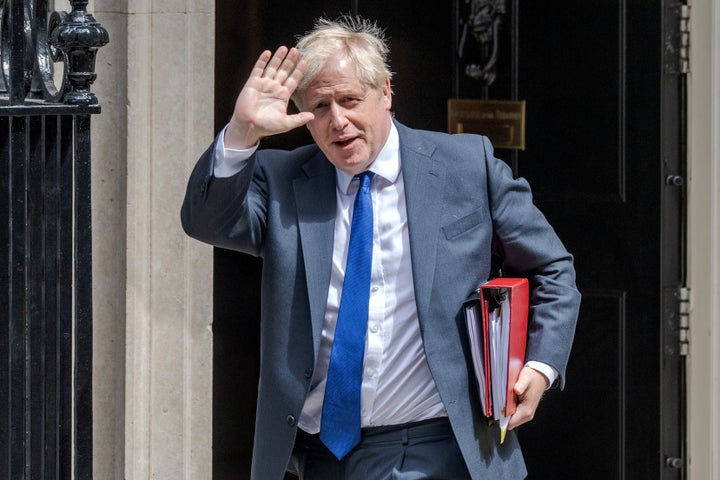
Boris Johnson has resigned, after more than 50 Tory MPs dramatically quit in protest at his leadership.
This is what could happen next.
The Conservative Party will need to elect a new leader, who will automatically become prime minister. They do not need to hold a general election.
However this could take some time.
Tory leadership elections have two parts. The first stage sees Tory MPs vote in a series of rounds, whittling the list of candidates down to a final two.
In the 2019 leadership race this took roughly two weeks. But it could take longer depending on how many candidates stand.
The second stage sees the final two candidates go to a vote of Tory members. In 2019, when Johnson took on Jeremy Hunt, this took around a month.
Leadership candidates have on manoeuvres in Westminster in the expectation of a contest for months.
While the contest takes place, the country will still need a prime minister to govern the country.
Johnson has suggested he wants to remain in office as a caretaker prime minister until the Tory party conference in October.
Nick Gibb, a former schools minister, said: “As well as resigning as party leader the PM must resign his office.”
“After losing so many ministers, he has lost the trust and authority required to continue. We need an acting PM who is not a candidate for leader to stabilise the government while a new leader is elected.”
Simon Hoare, the chairman of the Commons Northern Ireland committee, said: “Ministers resigned *because* of the PM. The party lost confidence *because* of the PM. It is beyond credulity that Mr Johnson can stay in office even pro tem. New constitutional territory but he has to go and go means go.”
If not Johnson, Dominic Raab, the deputy prime minister, is seen as the most likely interim-leader, especially given he has ruled himself out of standing in the leadership contest.
One immediate action a caretaker PM will need to take, whether it is Johnson or someone else, is to fill all the empty ministerial posts.
For example, there are currently no ministers in the Department for Education
It is likely most if not all the ministers and ministerial aides who resigned over the course of the last two days could be reappointed to the same positions.
Once the party elects a new leader, they would have until January 2025 before they had to call a general election.
Attorney general Suella Braverman has already announced she intends to stand.
Other likely candidates include foreign secretary Liz Truss, former chancellor Rishi Sunak, former health secretary Sajid Javid and defence secretary Ben Walllace. Jeremy Hunt has also not ruled out a second bid for the top job.
will automatically become prime minister. They do not need to hold a general election.
However this could take some time.
Tory leadership elections have two parts. The first stage sees Tory MPs vote in a series of rounds, whittling the list of candidates down to a final two.
In the 2019 leadership race this took roughly two weeks. But it could take longer depending on how many candidates stand.
The second stage sees the final two candidates go to a vote of Tory members. In 2019, when Johnson took on Jeremy Hunt, this took around a month.
Leadership candidates have on manoeuvres in Westminster in the expectation of a contest for months.
While the contest takes place, the country will still need a prime minister to govern the country.
Johnson has suggested he wants to remain in office as a caretaker prime minister until the Tory party conference in October.
Nick Gibb, a former schools minister, said: “As well as resigning as party leader the PM must resign his office.”
“After losing so many ministers, he has lost the trust and authority required to continue. We need an acting PM who is not a candidate for leader to stabilise the government while a new leader is elected.”
Simon Hoare, the chairman of the Commons Northern Ireland committee, said: “Ministers resigned *because* of the PM. The party lost confidence *because* of the PM. It is beyond credulity that Mr Johnson can stay in office even pro tem. New constitutional territory but he has to go and go means go.”
If not Johnson, Dominic Raab, the deputy prime minister, is seen as the most likely interim-leader, especially given he has ruled himself out of standing in the leadership contest.
One immediate action a caretaker PM will need to take, whether it is Johnson or someone else, is to fill all the empty ministerial posts.
For example, there are currently no ministers in the Department for Education
It is likely most if not all the ministers and ministerial aides who resigned over the course of the last two days could be reappointed to the same positions.
Once the party elects a new leader, they would have until January 2025 before they had to call a general election.
Attorney general Suella Braverman has already announced she intends to stand.
Other likely candidates include foreign secretary Liz Truss, former chancellor Rishi Sunak, former health secretary Sajid Javid and defence secretary Ben Walllace. Jeremy Hunt has also not ruled out a second bid for the top job.
